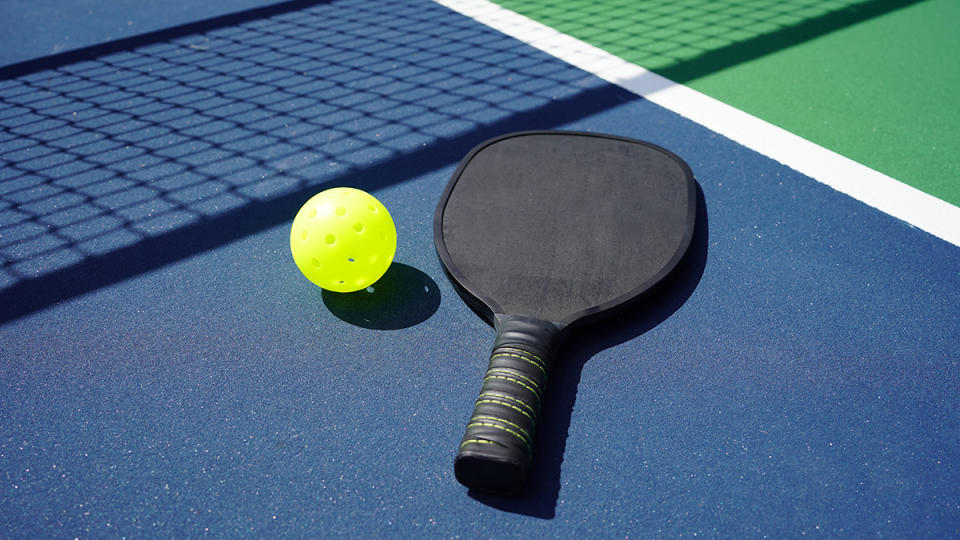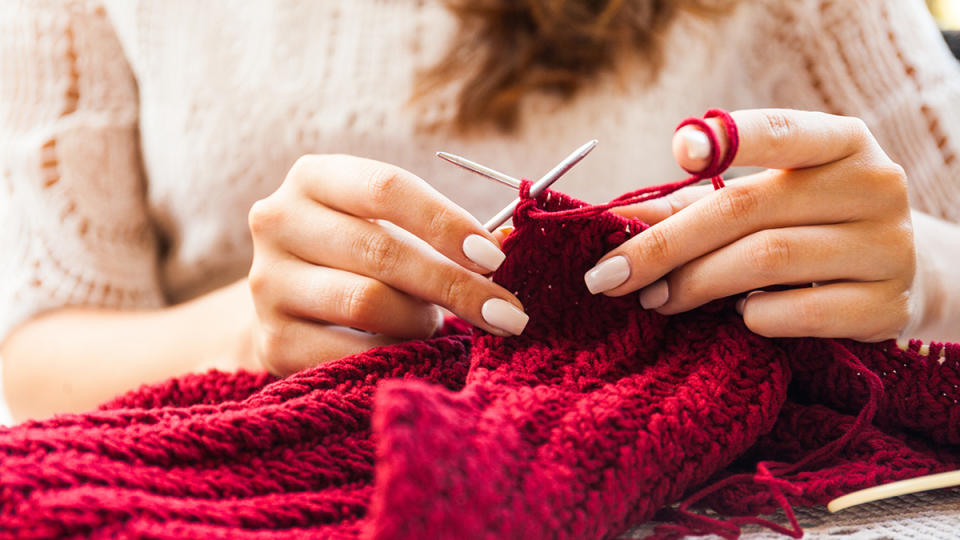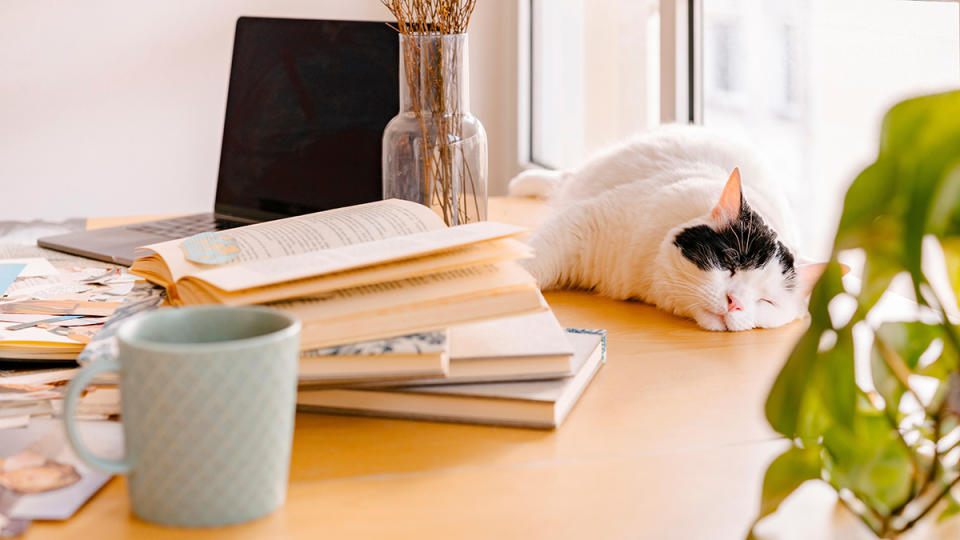The Best Hobbies for Women Over 50 — And The Surprising Health Benefits of Each
Hobbies for women over 50 are exploding in popularity because more of us are carving out time for leisure activities such as pickleball, knitting, board games, plant parenting, playing cards, and spending time in nature. And while taking a break to enjoy yourself is healthy in and of itself, new research reveals that your favorite hobbies have additional benefits. Interested in having fun and bolstering your health at the same time? Read on to find out what the most popular pastimes can do for you.
Playing a board game boosts your ability to problem-solve

You’re not the only one who loves the nostalgia of competing head-to-head over an old-fashioned board game. In a recent survey, around 70% of women over 50 said board games are a hobby they enjoy, too. And game manufacturers are listening! To make their games even more fun for older players, Hasbro just released new versions of the well-known classics Scrabble, Trivial Pursuit, and The Game of Life with bigger pieces, easier-to-read text and generation-specific play options. (Buy from JoyForAll.com/pages/board-games)
Reliving childhood memories isn’t the only benefit you get from playing board games. They also help you come up with an ingenious plan or solution that you’ve been stuck on. That’s the news from research in the Journal of Creative Behavior. Scientists asked folks who had trouble producing creative ideas to play a board game. Afterward, the players generated solutions that were significantly more imaginative.
“Board games can be powerful tools to enhance our ability to think creatively,” says Jenny Woo, PhD, founder of MindBrainEmotion.com and creator of the card game 52 Essential Life Skills. (Buy from Amazon.com, $24.99)
“The act of playing a board game can stimulate our brains and suspend skepticism, which allows us to be more open to exploring new ideas,” Woo adds.
Taking up pickleball wards off depression

Invented in 1965 on Bainbridge Island in Washington state, pickleball has been the fastest-growing sport in America for the past 3 years, according to the Sports & Fitness Industry Association. Not only that, but this hobby is growing in popularity more quickly among women, and adults over 50 play it most frequently.
That’s great news since researchers reporting in Frontiers in Psychology found that folks over 50 who regularly play pickleball are significantly happier. One reason is because of how quickly you can get started.
“Pickleball is often considered a relatively accessible sport, particularly for beginners and middle-aged adults,” says Marlin Chris Wolf, PhD, a psychologist at GrowTherapy.com. “It features a smaller court size, slower ball speed and lighter paddles compared to sports like tennis, making it easier to pick up and play.”
What's more, pickleball combines several proven joy-boosting benefits in one game. For example, it’s an easy way to stay active. “Regular exercise has been linked to improved mental well-being, reduced stress levels and increased overall happiness,” notes Wolf.
And because it’s played with others, you get to meet new people. “The social aspect of the game can provide opportunities for building friendships, social support and a sense of belonging,” he adds. Plus, it’s fun! “Engaging in activities that bring pleasure and a sense of accomplishment can have positive effects on mood.”
Taking a knitting break improves your memory

Knitting, crocheting and other handicrafts have surged in popularity in recent years with more than 45 million Americans picking up needles and yarn. The top reason why so many are flocking to it? According to a survey of 3,100 knitters and crocheters, it gives you an artistic outlet.
Now, researchers say channeling your inner artist has a surprising benefit: It sharpens a fuzzy memory. In a study in the journal Geriatric Nursing, researchers asked folks between the ages of 64 to 72 with mild memory loss to do artistic crafts (such as painting, collaging and knitting) for 60 to 90 minutes twice a week. By the end of 6 weeks, art-makers experienced a significant improvement in short-term and long-term memory, decision-making abilities and attention.
It’s no coincidence that knitting and other creative activities use all of these specific brain skills. “When I was at UCLA, we did a lot of studies with fMRI and PET scans showing that when people perform a task, the part of the brain that controls the task gets stronger and more efficient,” says Gary Small, MD, professor and chair of psychiatry at Hackensack University Medical Center and author of The Memory Bible. (Buy from Amazon.com, $15.99) “It’s the same as with physical exercise: Use it or lose it.”
Getting lost in a good book sharpens your recall

Permission to ditch your to-dos and carve out some time to dive into the latest bestseller. Doing so can sharpen your recall. In a study from the University of Illinois Urbana-Champaign, folks 60 and over who read engrossing novels, biographies and historical books for 90 minutes a day 5 days a week improved their episodic memory (helping you recall events) and working memory (helping you juggle multiple pieces of information at once) within 8 weeks. Keeping track of storylines and remembering details as you read bolsters memory-managing areas of the brain.
Tending to your houseplants fends off fatigue

Indoor and outdoor gardening has recently seen explosive growth, with 18.3 million new “plant parents” of all ages planting flowers, vegetables and herbs from 2020 to 2021 alone. And their gardens are just getting bigger. In a recent survey, up to 46% of women over 50 who garden as a hobby say they intend to plant the same amount or even more this year than they did last year.
If you’ve been developing your green thumb, too, consider placing more live plants (such as golden pothos and fiddle leaf figs) in the areas of your home where you spend the most time. Doing so will keep your energy up throughout the day, reveals a new study in the journal Indoor Air. Plants reduce the build-up of drowsiness-triggering carbon dioxide that we exhale by absorbing it through their leaves, keeping you alert.
Tip: Brown thumb? Take a stroll instead. Research in BMJ Open found folks seated at a desk who took a 3-minute leisurely walk every 30 minutes experienced significantly less fatigue and more energy throughout the day. Breaking up prolonged sitting with light-intensity walking spurs the release of pep-boosting chemicals (like norepinephrine) and boosts circulation for a quick pick-me-up.
Challenging friends to bridge sharpens hearing
A whopping 8 out of 10 women over 50 say playing card games (such as bridge, canasta and poker) is among their favorite hobbies. One big reason is because it gives them a chance to connect with loved ones. Surveys show 95% of card gamers enjoy playing alongside friends and 72% look forward to playing with family members.
Now, there’s another important reason to grab a deck and start shuffling: It can improve your hearing. A study in the European Journal of Ageing found that adults 60 to 80 years old who played card games once per week for about 3 hours were better at hearing people talk even when there was background noise. The researchers suspect that playing a card game that involves strategic planning and following rules to win may strengthen your brain. This, in turn, bolsters perceptual abilities that help you detect speech more easily.
Tip: Singing works, too! When women between the ages of 54 and 79 signed up to sing for 2 hours each week in a choral group in addition to practicing at home 1 hour each week, their ability to hear conversation (even in noisy areas) improved up to 20% within 10 weeks. Researchers reporting in Frontiers in Neuroscience say that singing trains the brain to search for specific musical notes, which then sharpens your ability to hear sounds in speech.
Spending time in nature soothes pain
More and more of us are spending time in a park, arboretum or our own backyard. In fact, the number of women in their 50s who are making nature visits their hobby rose by 14% since 2020. And the number of women 65 and older who adopted this hobby increased by nearly 17%, accounting for the fastest growing group of people enjoying nature outings.
Decreasing stress is one good reason to step outside. Another is reducing ongoing pain, such as arthritis and back aches. A study in Environmental Research found that being around trees, grass and other greenery reduces chronic pain. It may be due to pain-quashing compounds (phytoncides) that plants release into the air that we then breathe in. Plus, the sights and sounds of nature calm us, resulting in less pain.
And if you can find group of likeminded folks to join you on your nature breaks, you'll bolster the benefits. Research out of the University of Oxford found that folks who had larger social networks had lower pain sensitivity. Bonding with others (such as through fun clubs and social groups) spurs the production of pain-masking endorphins.
This content is not a substitute for professional medical advice or diagnosis. Always consult your physician before pursuing any treatment plan.
A version of this article originally appeared in our print magazine, Woman's World.
For more fall decorating tips, keep reading!
Backyard Decorating Ideas On a Budget
3 Fall Mantel Decor Ideas for Your Home
Fall Wreaths for the Front Door to Say Hello to Autumn
Content created in collaboration with QVC. Price taken at the time of publication. Woman's World aims to feature only the best products and services. We update when possible, but deals expire and prices can change. If you buy something via one of our links, we may earn a commission.
Questions? Reach us at [email protected]
